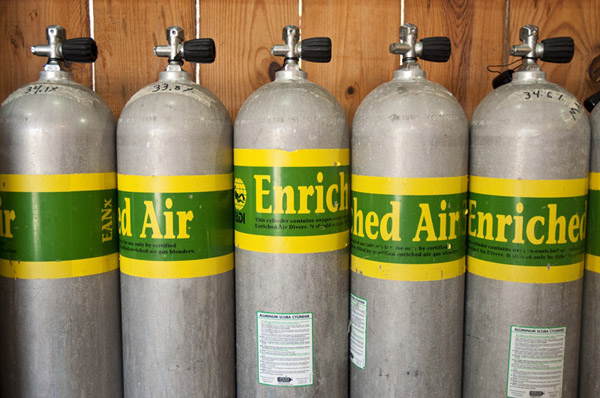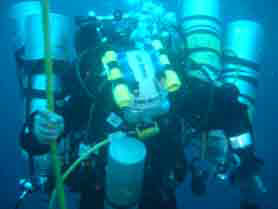Mixed Gas Diving

After taking advanced diving
courses it is possible to dive with enriched air,
also known as nitrox. This air contains 32 percent
oxygen in comparison to the 21 percent of the
atmosphere and with it comes a reduced amount of
nitrogen at only 68 percent. Because the amount of
nitrogen is less per breath, the partial pressure
of nitrogen at depth is decreased, reducing the
chance of decompression sickness and increasing
bottom time. The downside of this method is that
you must also pay attention to the partial
pressure of oxygen in your system which is why
further classes are required. Just like with
nitrogen, if the partial pressure of oxygen
becomes too high it can cause injury, in this case
seizures and possible death. However unlike the
decompression sickness, this injury is caused by
having too much oxygen in your system at one time.
This is contrasted with decompression sickness
which is caused by not only having too much
nitrogen but also coming up too fast allowing the
nitrogen to expand in your system. The danger of
enriched air can therefore be largely avoided by
staying above your max depth to avoid these high
oxygen partial pressures. Because of this, using
enriched air with conservative diving is largely
considered to be a much safer option than diving
with normal air.
A common
misconception around enriched air or nitrox
diving is that it allows you do go deeper while
being safer. As explained above this is
completely false as diving to the depths that
can safely be reached for brief periods with
normal air is actually quite dangerous with
nirtox as the partial pressure of oxygen becomes
too high. Instead what people people are
thinking of is a different method of mixed gas
diving called Trimix. This method uses helium in
addition to nitrogen and oxygen in order to
lower the effect of nitrogen narcosis (a altered
state of mind caused by too much nitrogen inside
of your body). This system also further lowers
the oxygen to below atmospheric levels to
decrease the depths at which the partial
pressure of oxygen becomes to high for the body.
Because helium is so easily absorbed into the
body and the body breathes nitrogen at such
depths several decompression stops are required
to prevent decompression sickness. This method
also commonly utilizes multiple tanks with
different types of gas in each that they change
depending on their depth. As such, this type of
diving is not used by civilian/recreational
divers but is instead only used by
technical/military divers.

